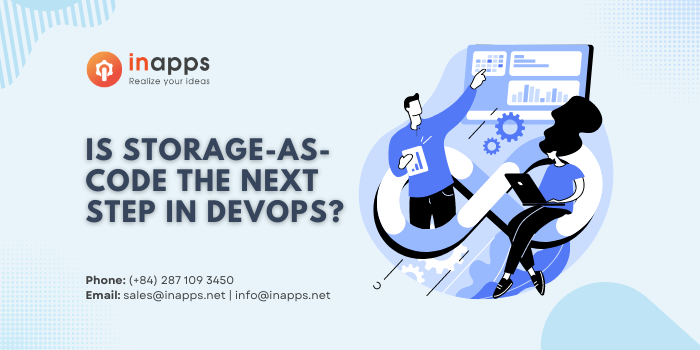- Home
- >
- DevOps News
- >
- Is Storage-as-Code the Next Step in DevOps?
The next evolution of DevOps has arrived. Sometimes called AppOps, this move gives developers the reins over at least part of their underlying infrastructure by automating the managing and provisioning of Infrastructure as Code (IaC) — without the cognitive overload of becoming a so-called full stack developer. Or infrastructure teams burning out as they respond to tickets that increase alongside the speed of deployment.
If proper guardrails and policies are in place as code, teams are empowered to make decisions, while errors and costs are reduced. Then, both application developers and infrastructure engineers can work on creative problems whose solutions enhance business value, further delivering on the promise of DevOps.
The folks at Pure Storage contend that the logical next extension of this is what they’ve dubbed as Storage-as-Code. Storage then goes from becoming another bottleneck to another part of the essential DevOps single source of truth.
When done correctly, Storage-as-Code should embrace the agility and scalability of the cloud computing model, irrespective of the environment or who needs to access it.
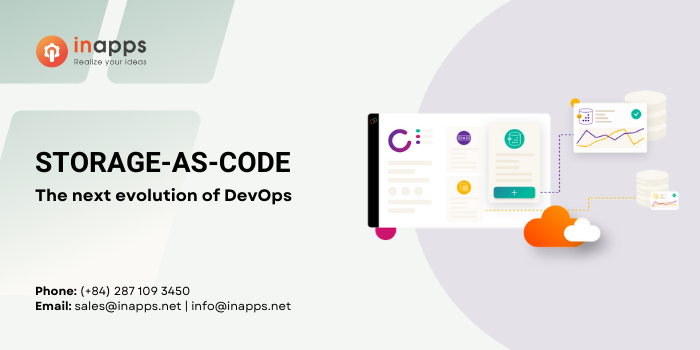
Storage-as-Code in a Hybrid World
Very few enterprises are pure public cloud. Most organizations prefer a hybrid approach, with most app modernization plans pursuing some mix of public and private cloud, on-premise and edge computing.
When developers need cloud resources like storage, networking and computing, they access them on-demand via Terraform, Dan Kogan, vice president of product management and marketing at Pure Storage, told InApps Technology.
But in traditional on-premise architecture, these same developers are opening an IT ticket, which ensures a long discussion around provisioning and how to procure on-prem infrastructure. The latter process can take weeks or months.
The core of Pure Storage is an operating system called Purity that runs on-premise on devices in the FlashArray family and in the cloud via Cloud Block Store — but, Kogan said, though they bear different names, they are actually the same code and product, just working in different environments.
As its name implies, Pure Fusion, looks to virtualize across locations to make the cloud an operating model more than a destination. “Whether you’re running on-prem, the edge, or public cloud, you can operate in the same operating model,” he said.
Instead of cloud-versus-on-premise decision making, Pure Fusion provides a topology model with regions and availability zones, combined with policy-based provision approaches around classes of storage. The infrastructure team can determine data protection policies and host access to storage across the entire organization.
Pure Fusion brings visibility, scalability, instant availability, intelligent workloads, and a service-level agreements (SLAs) approach to cloud computing and extends it to the FlashArray family products.
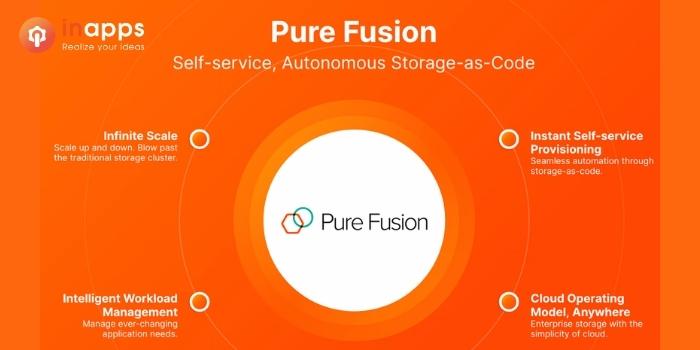
About a dozen Pure Storage customers have tested Pure Fusion, including several of the world’s largest financial institutions, building their own versions of hyper-scale clouds within their data centers.
The experience, according to Kogan, is a lot like that of the big cloud providers, even with customer-facing portals, but these large, well-regulated industries only want their infrastructural and DevOps models to mimic the hyper-scale cloud — to gain the benefits without the added cost, security and scaling challenges that can come with the public cloud.
Storage-as-Code and the Future of DevOps
It’s not a surprising next step that storage would be a part of the ever-encompassing DevOps universe.
By being able to enforce Policy-as-Code through Infrastructure-as-Code, infrastructure teams can offer a menu of services, including storage, available on-demand via an API call, as an alternative to constantly responding to the same tickets. After all, at the crux of DevOps is the promise of never doing the same thing twice, so all engineers can be collaborative, creative workers.
Anthony Ferrario, product management lead for APIs and developer experience at Pure Storage, views this as part of a trend of traditional storage specialists upskilling to move into the DevOps space and “away from being that painful, ticket-serving person.”
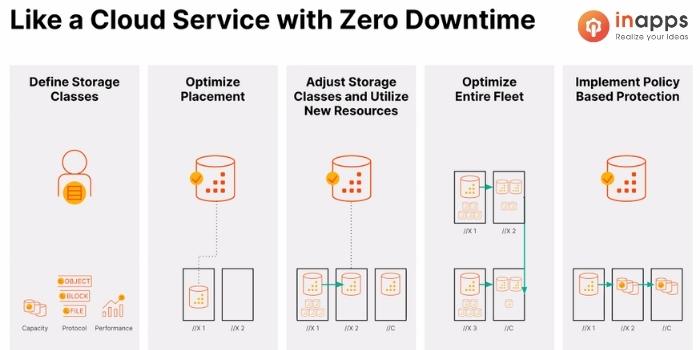
By learning through Pure Fusion how to architect the application from a topology and layout perspective, he says, these engineers are more able to define, build and provide infrastructure on demand. This is another way IT can continue to provide more measurable business value.
“Large storage teams and IT organizations are looking to move into this kind of model,” he said. “People are excited to get out of that drudgery piece and build something as code.”
And while developers aren’t the decision-makers or the budget holders for the storage market, Ferrario says, they are also a key influencer audience.
“The IT developer knows they are responsible for building and automating their own infrastructure services,” he said. “And while they don’t hold the purse strings, they are the executors.”
This is a logical trend to follow the popular Kubernetes abstraction, Ferrario said; there’s a widespread demand for infrastructure to be generic enough for everyone to access what they need to build, without having to bug infrastructure engineers all the time. Move faster, with guardrails and policy in place.
“If you look at the origin of the cloud operating model years ago, the infrastructure that you as a developer or app owner need is on-demand — and you don’t have to worry about what’s going on behind the scenes,” Ferrario said. But when it’s on-premises, the process is still manual. “You need that Infrastructure-as-a-Service in place, with policy definition and so on.”
On the other hand, he contended, if you aren’t building your Infrastructure-as-Code and if you’re not delivering your Infrastructure-as-a-Service, then you’re not really building with a cloud mindset — no matter where you store.
This is because IaC and IaaS are expectations of both cloud buyers and cloud consumers. Especially in a hybrid world, Ferrario argued, the cloud practice of codifying everything should spread across environments and roles.
What is DevOps in Cloud Computing?
- Enables automation & infra modernization at the same time
- Helps to achieve cloud server replication easily
- Helps to monitor resource utilization through custom alerts
- Eliminates the complexity of backups
- Enables infra orchestration by integrating tools such as Chef, Puppet and Ansible with Cloud
- Enables one-click deployment improving time to market
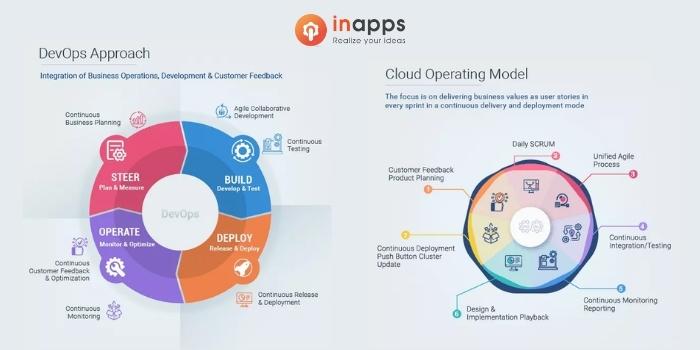
We hope this tutorial has helped you. It’s not as difficult as you think it. Just go through the entire process once and practically implement it. Also, in case of any queries, you can contact InApps. We would love to help you.
[sociallocker id=”2721″]
List keywords our users find our article on Google
| wawa menu |
| devops storage |
| hybrid flash array |
| hire terraform developers |
| wawa delivery |
| collaborative sales ideology |
| pure storage cloud |
| hire dedicated hybrid blockchain developer |
| jira code block |
| devops |
| the next step wikipedia |
| pure storage jobs |
| hire jira developers |
| portworx |
| pure cloud block store |
| hyperscale models |
| hire hybrid blockchain developer |
| hyperscale cloud data center |
| pure office solutions |
| hyperscale cloud |
| on demand delivery app development company |
| pure storage linkedin |
| devops wikipedia |
| hybrid cloud definition wikipedia |
| capital one full stack |
| flasharray m specs |
| pure storage portworx |
| flasharray m technical specifications |
| flasharray m specifications |
| pure storage demo |
| jira vs devops |
| pure flash array |
| pure storage cloud block store |
| pure storage flash array |
| offshore hybrid blockchain developer |
| on demand mobile app development company |
| full stack digital commerce |
| hyperscale cloud providers |
| mobile app development company |
| “portworx” |
| public storage customer service representative |
| pure storage wiki |
| pure storage review |
| etsy wikipedia |
| create a custom event in jira cloud |
| capital one devops |
| next step healthcare jobs |
| portworx kubernetes |
| hashicorp jobs |
| move jira ticket to another project |
| portworx pure storage |
| capital one interview case study |
| cto linkedin profile service |
| ops code |
| pure source recruitment |
| centric infrastructure group |
| capital one ci/cd |
| pure cloud storage |
| happy day touristik |
| terraform icon |
| kogan mobile plans |
| pure visibility |
| pure storage x |
| storage modernization model |
| cloud block store |
| saas or on premise help desk software |
| top mobile app development company |
| hyperscale data center definition |
| app development company |
| software and app development company |
| web and mobile app development company |
| web development outsourcing company |
| custom mobile app development company |
| purestorage linkedin |
| public storage |
| hcmc |
| linkedin pure storage |
| “infrastructure as code” |
| “centric infrastructure group” |
| ho chi minh wikipedia |
| portworx jobs |
| intelligent building wikipedia |
| kogan product review |
| pure storage blog |
| pegas wikipedia |
| blockstore |
| hire terraform developer |
| wawa inc. jobs |
| pure storage culture |
| pure storage flasharray reviews |
| outsourcing influencer marketing fintech |
| hybrid topology wikipedia |
| private hashicorp registry |
| hire jira developer |
| kiran zaidi |
| product decision wikipedia |
| wawa menu today |
| hygieia group |
| jira core data center |
| marketing mix modeling wiki |
| pure storage protection groups |
| visually design your cloud infrastructure |
| game based learning wikipedia |
| jira ticket templates |
| portworx storage |
| vsts devops vs jira |
| devops icon |
| kiran agrahara |
| portfolioe for jira custom fields |
| wawa online order |
| storage architect jobs |
| anthony ferrario |
| phunware public |
| product manager capital one |
| blockchain fintech or devops |
| next level hospitality services jobs |
| purestorage.com |
| purestrage セキュリティ |
| jira portfolio custom fields |
| portworx open source |
| unit testing wikipedia |
| jira service desk admin add custom field added to all issues |
| kogan app |
| filter by custom fields in jira porfolio |
| hire velocity developer |
| hybrid flash-array |
| jira cloud mobile app |
| jira custom field manager |
| visual studio devops |
| jira cloud find id of custom field |
| promise land 50k 2022 |
| visual studio 2017 workloads |
| pure storage purity version |
| terraform by hashicorp |
| wikipedia website template |
| e commerce offshore vietnam |
| pure storage ceo |
| development panel jira |
| jira message custom field |
| jira ticket template |
| operating model design consultancy fintech |
| visual studio live unit testing |
| cd holders storage |
| pure file storage |
| add custom fields to story jira |
| jira service desk technology stack |
| kogan mobile |
| portfolio for jira demo |
| visual studio jira |
| deployment models of cloud computing wiki |
| hyper recruitment solutions |
| jira visual studio |
| keywords studios wikipedia |
| jira ticket |
| kiran it solutions |
| mobile app ux case study |
| pure storage kubernetes |
| description templates for jira cloud |
| jira issue icons |
| jira wikipedia |
| pure agility |
| pure cloud |
| pure storage flash array pricing |
| velocity in jira |
| custom upload field jira |
| hire fusion developer |
| jira portfolio cloud |
| toby keith cd |
| visual devops |
| is kogan mobile good |
| jira database custom field |
| pure block storage |
| template ticket jira |
| velocity jira |
| custom jira cloud template |
| hire kubernetes developer |
| operating model design business consultant fintech |
| operating model design management consultant fintech |
| pure storage flasharray |
| pure storage products |
| purestrage アクセス |
| topological code |
| “crux marketing” |
| essential custom fields for jira® |
| flasharray |
| infrastructure as code says |
| pure recruitment |
| pure storage erfahrungen |
| terraform developer job description template |
| cloud block store pure storage |
| jira stored in table custom fields |
| kogan data plans |
| pure storage block |
| pure storage end of life |
| storage studios storage and organization |
| hire visual studio developers |
| pure kubernetes |
| pure storage cloud block storage |
| purse storage solutions |
| onpremise ticketing system |
| model ops |
| devops vs cloud computing |
| devops definition |
| cloud and devops |
| greatest web development agencies |
| operating model design |
| call center offshore outsourcing |
| what is devops in cloud computing |
| devops and cloud computing |
| devops cloud computing |
| devops cloud services |
| application development cloud computing |
| cloud and devops services |
| on demand food delivery app development |
| ecommerce app development company |
| software development services |
| outsourcing web development company |
| website app development services |
| hybrid app development |
[/sociallocker]
Let’s create the next big thing together!
Coming together is a beginning. Keeping together is progress. Working together is success.




